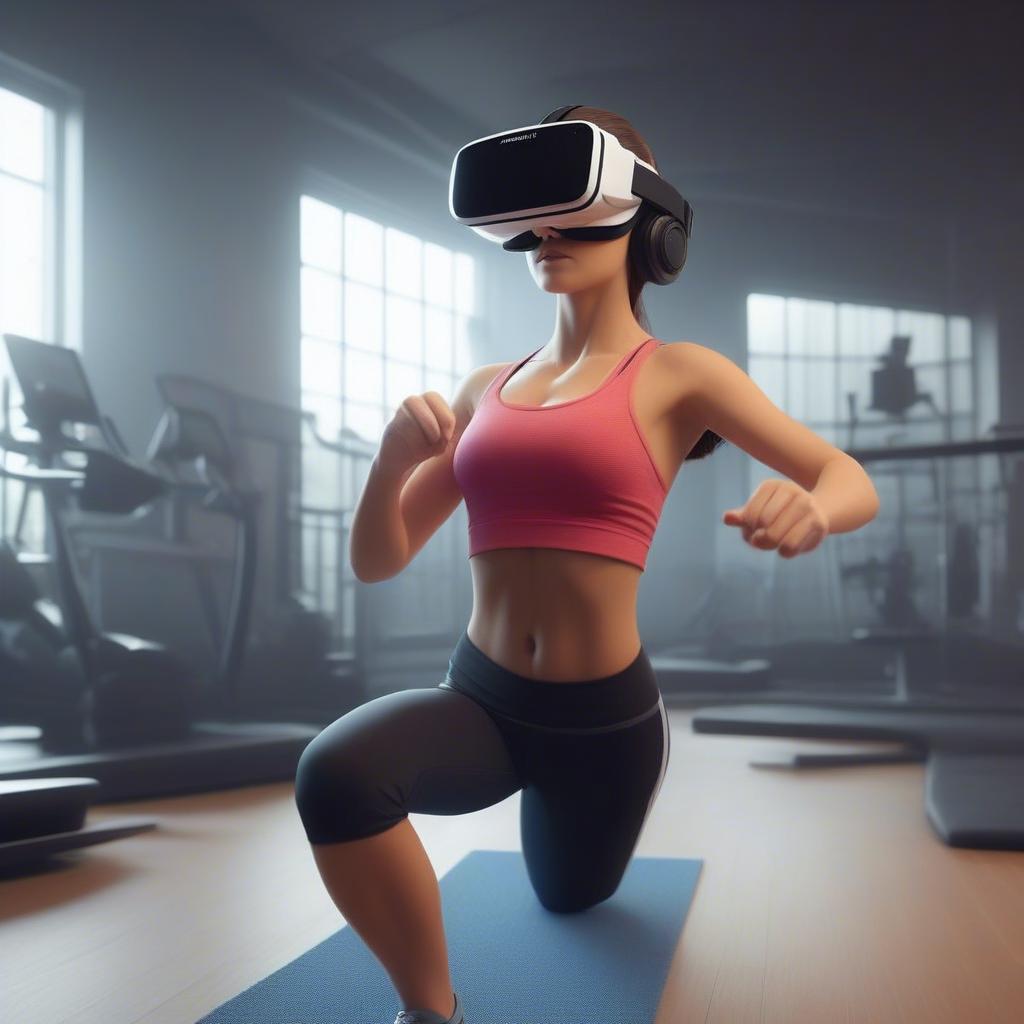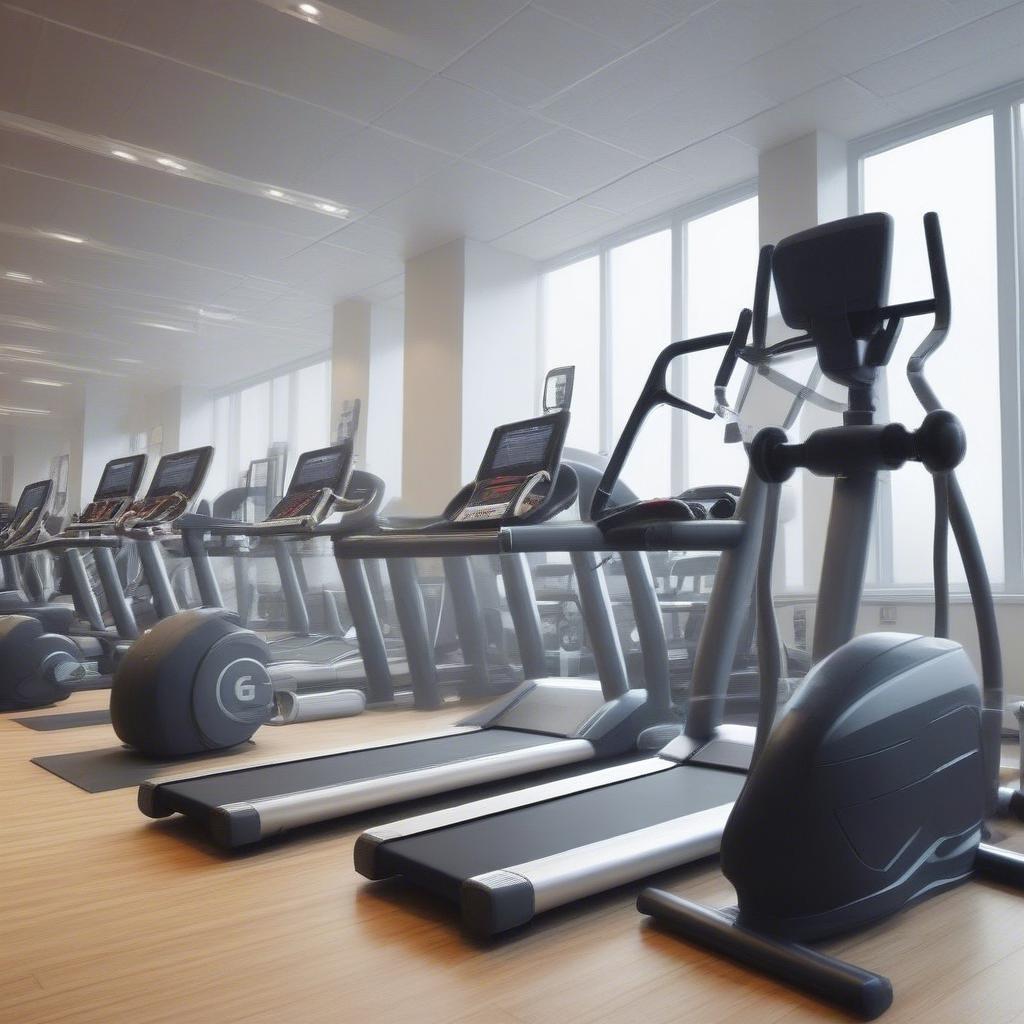
Introduction: Stepping into a New Dimension of Exercise
Forget the monotonous treadmill and the predictable gym routine. The future of fitness is here, and it’s immersive, exhilarating, and totally transformative. We’re talking about VR fitness, a revolutionary approach to exercise that’s taking the world by storm. Imagine working out in a tropical paradise, boxing in a futuristic arena, or hiking through the Himalayas – all from the comfort of your living room. This isn’t science fiction; it’s the reality of virtual workouts, and it’s changing how we think about getting fit.
Why VR Fitness is Gaining Momentum
The rise of gym technology has been gradual, but the jump to virtual reality is a game changer. Why? Because VR fitness tackles some of the biggest challenges of traditional exercise:
- Boredom: The repetitive nature of many workouts can lead to disengagement. VR combats this with engaging, interactive experiences that make time fly.
- Motivation: It’s hard to push yourself when you’re staring at a wall. VR provides goals, challenges, and a sense of accomplishment within immersive environments.
- Accessibility: Weather, location, and expensive gym memberships are no longer barriers. VR workouts can be done anytime, anywhere.
- Personalization: From intensity levels to music selection, VR fitness can be tailored to individual preferences and fitness levels.
What Exactly is VR Fitness?
At its core, VR fitness uses virtual reality technology to create immersive and interactive workout experiences. It involves wearing a VR headset that transports you to a virtual environment, along with motion-tracking controllers that allow you to engage with the simulated world.
How Does It Work?
- The Headset: A VR headset displays the virtual environment, wrapping around your eyes to create a 3D experience.
- The Controllers: Handheld controllers track your movements and translate them into actions within the virtual world.
- The Software: Specialized fitness apps and games create engaging workouts, from boxing matches and dance routines to virtual hiking and cycling.
- The Experience: As you move, the VR software tracks your performance, providing feedback and tracking progress.
Types of Virtual Workouts Available
The world of virtual workouts is surprisingly diverse. Here’s a peek at what you can find:
- Cardio: From high-intensity interval training (HIIT) and boxing to dance and rhythm-based games, there are plenty of options to get your heart rate up.
- Strength Training: Some apps simulate weightlifting, using controllers to replicate the feeling of lifting virtual barbells or dumbbells.
- Yoga and Meditation: Immersive environments and guided instructions create calming and relaxing spaces for mindful movement.
- Cycling and Rowing: Virtual environments simulate outdoor cycling or rowing, making indoor workouts more engaging.
- Gaming-Inspired Fitness: Many popular VR games incorporate movement as part of the gameplay, turning exercise into an entertaining activity.
The Science Behind the Benefits: Why VR Fitness Works
It’s not just a novelty; VR fitness offers some compelling benefits that are backed by research. Here’s a look at why it’s so effective:
Improved Motivation and Adherence
The biggest hurdle in fitness is consistency. VR workouts help you stay engaged through:
- Gamification: Turning exercise into a game makes it more enjoyable and less like a chore.
- Immersion: Feeling like you’re in the workout makes it more exciting and distracting from the discomfort.
- Personalized Goals: Tracking progress and setting individual goals gives a sense of accomplishment.
- Reduced Perceived Exertion: Immersive visuals and engaging gameplay can reduce the perceived difficulty of the workout.
Enhanced Physical Performance
VR fitness can improve your physical fitness by:
- Boosting Cardiovascular Health: Many VR games involve movement that gets the heart pumping.
- Improving Balance and Coordination: Movements and challenges in VR can enhance your balance and agility.
- Increasing Strength and Endurance: Some VR games and apps are designed to build strength and stamina.
- Promoting Calorie Burn: Engaging in active virtual workouts helps to burn calories, which can contribute to weight loss.
Cognitive and Mental Well-being
VR fitness offers benefits beyond physical fitness:
- Stress Reduction: Immersive and calming VR environments can provide a sense of escape and relaxation.
- Improved Mood: Exercise in general releases endorphins, and VR workouts are no exception.
- Cognitive Enhancement: Some VR games require quick thinking and reaction, which can improve cognitive function.
Getting Started with VR Fitness: A Step-by-Step Guide
Ready to jump into the world of virtual workouts? Here’s a practical guide to get you started:
Step 1: Choosing Your VR Headset
The first step is choosing a VR headset. There are different options on the market, each with its own pros and cons:
- Standalone Headsets: These are wireless and self-contained, offering the most freedom of movement. Examples include the Meta Quest 2 and Meta Quest 3.
- PC-Tethered Headsets: These need to be connected to a powerful computer, offering higher-fidelity graphics but limiting mobility. Examples include the HTC Vive and Valve Index.
- Mobile VR Headsets: These use your smartphone as the display and are generally the most affordable option. However, they usually offer a less immersive experience.
Tip: Consider your budget, desired level of immersion, and the space you have available when choosing a headset. Research different headsets and read reviews to find one that fits your needs.
Step 2: Setting Up Your VR Space
Once you have your headset, you need a safe and spacious environment to workout. Here’s what to keep in mind:
- Clear the Area: Remove any furniture, rugs, or obstacles that might get in your way.
- Create Enough Space: Make sure you have enough space to move around freely without hitting anything. A minimum of 6×6 feet is generally recommended.
- Stay Aware of Your Surroundings: Be mindful of pets or people who might enter your play area while you’re using the headset.
- Adjust Lighting: Make sure the lighting is bright enough to avoid tripping or disorientation, but not so bright that it interferes with your experience.
- Comfort is Key: Make sure the space is at a comfortable temperature and free from distractions.
Tip: Use the headset’s boundary system to mark the limits of your play area.
Step 3: Selecting Your VR Fitness Apps
The next step is finding the right fitness apps. There are many options available, so here are a few tips for choosing the best one for you:
- Consider Your Fitness Goals: Are you looking to improve cardio, build strength, or reduce stress? Choose apps that are tailored to your goals.
- Explore Different Genres: Try out different types of fitness apps, such as boxing, dance, or cycling, to find something you enjoy.
- Read Reviews: Read reviews from other users to get an idea of the quality and effectiveness of each app.
- Look for Variety: Choose an app with a variety of workouts and challenges to keep things interesting.
- Check for Compatibility: Make sure the app is compatible with your VR headset.
- Start Slow: Begin with short workouts and gradually increase the intensity and duration as you get more comfortable.
Examples of popular VR fitness apps:
- Beat Saber: A rhythm-based game that involves slicing through blocks with lightsabers.
- FitXR: Offers a variety of classes, including boxing, dance, and HIIT.
- Supernatural: Provides guided workouts with beautiful virtual environments.
- Pistol Whip: A high-energy shooter game that gets you moving.
- Les Mills Bodycombat: A martial arts-inspired fitness experience.
Tip: Many apps offer free trials, so try out a few before committing to a subscription.
Step 4: Following Proper Safety Guidelines
Safety is paramount when using VR, especially during physical activity. Here are some important guidelines to follow:
- Warm-Up Before Every Workout: Like any workout, warming up is crucial. Do some light stretches and cardio before starting your VR fitness routine.
- Listen to Your Body: Don’t push yourself too hard, especially when you’re starting out. Take breaks when you need to.
- Stay Hydrated: Drink plenty of water before, during, and after your workout.
- Be Mindful of Motion Sickness: Some people may experience motion sickness when using VR. If you feel dizzy or nauseous, stop immediately.
- Use Proper Equipment: Make sure your headset is properly adjusted and that your controllers are working correctly.
- Watch Your Surroundings: Even if you have a marked play area, be mindful of your surroundings and avoid moving too quickly.
Tip: If you experience discomfort, stop exercising immediately. Consult with your doctor if you have concerns.
Integrating VR Workouts into Your Fitness Routine
Integrating VR fitness into your routine can be seamless and enjoyable. Here are a few strategies for making it work:
Setting Realistic Goals
- Start Small: Begin with short, 15-30 minute workouts and gradually increase the duration and intensity.
- Be Consistent: Try to work out a few times a week at the same time.
- Track Your Progress: Monitor your progress to stay motivated and see how far you’ve come.
- Celebrate Achievements: Reward yourself for reaching goals, no matter how small.
Combining VR Fitness with Traditional Methods
- Use VR as a Supplement: Don’t replace all your traditional workouts with VR. Instead, integrate it as a fun and engaging supplement.
- Alternate Between VR and Other Activities: Alternate between VR workouts, gym sessions, and outdoor activities to keep things fresh.
- Use VR for Active Recovery: Use lighter VR workouts for active recovery on rest days.
Building a VR Fitness Community
- Join Online Forums and Groups: Connect with other VR fitness enthusiasts to share tips, motivation, and challenges.
- Participate in Virtual Challenges: Many VR fitness apps have challenges that allow you to compete with other users.
- Share Your Progress: Share your experiences with friends and family to inspire them and stay accountable.
The Future of VR Fitness: What’s Next?
The technology behind virtual workouts is constantly evolving. Here’s what we can expect in the future:
- More Realistic Environments: Expect virtual environments to become even more realistic and immersive.
- Advanced Tracking: Future headsets will incorporate more advanced tracking capabilities, accurately tracking your movements and biometric data.
- Integration with Wearables: Expect to see more seamless integration with fitness trackers and other wearable devices.
- Personalized Workouts: AI will be used to create personalized workout plans based on your individual needs and preferences.
- Social VR Fitness: Virtual workout classes with real-time interaction with trainers and other participants will become more common.
- Increased Accessibility: VR technology will become more affordable and accessible to more people.
How Learn Business Supports Businesses Embracing VR Fitness
The rise of VR fitness also presents opportunities for entrepreneurs and businesses. Whether you’re looking to launch a VR fitness startup, or integrate VR into your existing gym, Learn Business can provide you with the guidance and templates you need to succeed.
Guidance for VR Fitness Startups
- Business Planning: Learn Business offers templates and guides to create a robust business plan that addresses the unique aspects of the VR fitness industry.
- Market Analysis: Gain insight into market trends, customer demands, and competitive landscapes within the VR fitness sector.
- Funding and Investment: Access resources for funding and investment options, including pitch deck templates to impress investors.
- Product Development: Learn best practices for developing and launching successful VR fitness apps and equipment.
- Marketing Strategies: Develop a marketing plan tailored for the VR fitness market, using proven strategies to attract customers and build your brand.
Integration Strategies for Existing Gyms
- VR Equipment Procurement: Get advice on selecting the right VR equipment and software for your gym.
- Staff Training: Learn how to train your staff to effectively guide and support clients using VR technology.
- Program Design: Create engaging and effective VR fitness programs tailored to your client base.
- Marketing and Promotion: Develop effective marketing campaigns to promote your new VR fitness options to existing and new members.
- Customer Experience: Learn how to create an immersive and rewarding experience for your clients, ensuring they benefit from the latest in gym technology.
Templates to Streamline Your Operations
Learn Business provides a variety of templates tailored to your needs, including:
- Business Plans: Comprehensive templates for outlining your business model, goals, and strategies.
- Financial Projections: Tools to help you estimate revenue, expenses, and profitability.
- Marketing Plans: Templates for crafting effective marketing campaigns.
- Customer Feedback Forms: Tools to collect valuable feedback from your clients.
- Legal Templates: Access to necessary legal templates to protect your business.
By leveraging the resources and expertise offered by Learn Business, you can confidently navigate the evolving landscape of the gym technology and maximize the potential of virtual workouts.
Conclusion: A New Era of Fitness
VR fitness is more than just a fad; it’s a groundbreaking shift in how we approach exercise. It offers a unique blend of fun, engagement, and effectiveness, making fitness more accessible and enjoyable for everyone. Whether you’re a seasoned athlete or just starting your fitness journey, virtual workouts provide an opportunity to break free from the mundane and embrace the future of fitness. As technology continues to advance, we can expect the world of VR fitness to become even more immersive, personalized, and impactful. Step into the virtual world and discover the transformative power of VR fitness – the future of fitness is here.



Leave a Reply